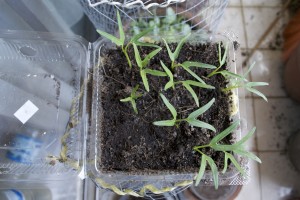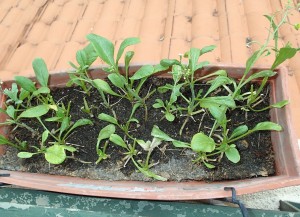7 veggies you can grow on the balcony… in Malaysia!

- 3.5KShares
- Facebook3.1K
- Twitter38
- LinkedIn37
- Email62
- WhatsApp207
Most Malaysians are hit by rising costs and the evil GST, so one way to save money is to grow your own food. Okay, eating fresh and literally from your hand-sown seeds isn’t exactly a new idea, what more with the government asking KL-ites to do it. While it may be doable for residents with a plot of land, what about those who live in condominiums who have little to no space to farm?
With the rising cost of living, many Malaysians find it difficult to own landed properties at decent prices, which is why condominiums seem to be the preferred choice nowadays. As of early 2014, the Real Estate Housing Developers Association recorded most of us living in the 1.5 million units of flats, condominiums and service apartments in Malaysia.
So, can living in pigeon holes create a favourable environment for Malaysians to grow their own vegetable patch?
The answer is: YES.
You don’t even need to be an experienced farmer to make this work. How do we know this? Well… This writer started her vegetable supply right in her condominium balcony. She found land too expensive and even buying a house with a garden was too much, but the urge to grow her own food drove her and her partner, Pat, to be creative.

Learning from her neighbours and being part of the team that set up TTDI Edible Project helped the pair convert pots, containers and other storage items into ‘beds’ where their green babies can grow. Watching YouTube videos and reading dozens of gardening books added to their knowledge.
Here’s what you need:

- A pot
- Some soil (TIP: Look for Organic soil under any brand, most nurseries have them, they should be RM2.50 to rM3 for 1kg, or if you buy more you can get a discount)
- Seeds (TIP: You can buy them from nurseries for less than RM5. Some packets have 10 seeds, some have hundreds. We like the brand Green World. Keep them in the refrigerator as heat can kills seeds.)
- Plenty of water
- Sunlight
- Some space (You don’t need a huge space – just a 2×5 ft balcony works fine, or perhaps even by a well-lit window)
Green fingersLots of TLC- Patience
1. Cabbage

Difficulty level: 3/10
Commonly thought to need cold weather, cabbages grow easily but you have to be patient. You’ll need to wait four to five months before eating it. Sow the seeds in dark and organic soil – a dark coloured soil is an indication of healthy soil, and plants need nutrients to survive.
Once it grows into a little seedling, you can transfer it to a bigger pot. Don’t forget to water regularly, and let it see the sun often too. Trimming the leaves speeds up the cabbage to form that head that you see often in the market.
2. Genovese Basil – from seed!

Difficulty level: 3/10
Normally you can cheat by buying the RM5 potted plants from Cold Storage supermarket, but why take short cuts? Grow them from seeds to go with your homemade margherita pizza or pesto sauce for your pasta nights. Pluck the leaves off regularly so it encourages fresh leaves to grow. Water and sun regularly.
You have to ‘prune‘ it too, which actually means to cut regularly to help fresh leaves grow. Old leaves will discourage the plant from ‘going to seed’ too fast, hence super-speeding their ageing process. ‘Going to seed’ means that the plant is at the end of its life cycle, so if you were to leave it alone, the plant would think that it’s time to ‘die’ soon, hence it produces seed to procreate.
Typically,this can happen in a month or two. So if you want to have a longer supply of basil, cutting it regularly will spur the growth of new leaves. It is a weird relationship, but it seems to work.
3. Kangkung

Difficulty level: 1/10
So cheap already, why bother growing it? But, it’s so easy, saving you a trip to the shops. Think of the time you save from finding parking, queuing to pay and driving home from the supermarket.
Kangkung has a hollow trunk and it loves water. But it is a hardy plant that can be ‘abused’, it won’t be upset if you forget to water it for a few days or even weeks. The young leaves look like claws and when it is older, you can eat the white flowers, known as morning glory as well. The Thais always have it in their menu, stir-fried with chillies or plain with garlic.
4. Edamame beans

Difficulty level: 4/10 (but much easier if you hired a Kebun Guard like our cat)
This favourite Japanese appetiser can be grown on balconies or in containers. Sowed similarly like the other vegetables, water it every three days and make sure it also gets sunlight.
It doesn’t climb like vines so it won’t be needing support such as sticks or railing. It grows like a shrub and you should be able to pick the beans in two to three months time. So after your little seeds show its first seedling, move the plant into a medium size pot. Despite edamame beans having a furry skin, the biggest problem with this sweet bean is that tree shrews are going steal them first. Our fat cat, aptly called Fatty, is seen defending the bean seedlings against a hungry shrew.

5. Tomatoes (and cucumbers)

Difficulty level: 4/10
These red jewels are happy in confined spaces as heat and humidity is not really a deterrent, but fruit flies are. So head on to Daiso to get those tiny nets and bag each fruit as you see it form. It requires regular watering and sunlight.
Tomatoes love calcium, so an easy way of getting this mineral to them is by crushing some eggshells and scattering the broken bits at the foot of the plant.
Cucumbers are a little more fussy… You have to grow it near a railing allow it to climb, feed it plenty of water and fertiliser, and you should get tiny little cucumbers to eat.
6. Lettuce

Difficulty level: 3/10
You can turn your balcony into a salad bar with this ‘ang moh’ vegetable. Keep them watered regularly and away from direct sunlight. If you have a medium-sized or large box, you can sow the seeds directly in this huge container without transferring it from smaller pots as we have done with the other plants.
If you want to really get into the ‘farm’ mode, grow them in rows, and it should line up nicely. Green salad leaves can be ready to eat in three to five months time.
Snails love them too, and if you’re living on the ground floor, these slimy leave eaters can get to it, slowly but easily. You can crush some egg shells and scatter them around the lettuce leaves, this deters the snails as they don’t like to glide over the pokey shells. Egg shells are a natural source of calcium too. The lettuce you grow may not be in supermarket sizes, so you may have to grow twice the amount you want to eat.
7. Choy Sum

Difficulty level: 3/10
Literally translated from Cantonese as Heart Veggie (or vegetable with a heart), it can grow easily in pots or seen here in a planter box, where you hang it off the railing. When you handle the seeds, be careful not to lose them. They are super tiny (kinda like mustard seeds), so it’s best to have delicate hands when you are sowing them.
Place them in a tiny pot with soil and water, and once they sprout say about four inches off the soil, you can transfer them into a bigger container. Planting choy sum together makes them ‘compete’ with each other, hence making them grow faster. You’ll need to water regularly and provide them with plenty of sunlight.
The leaves are naturally sweet, so you have to beware of pests. You can deter snails with the eggshell tip the same way you protect your lettuce, as its jaggedly edges discourages snails from getting close to your plants.
There’s more to plant
The list does go on if you are adventurous. Hong Kong Kai Lan can be easily grown, as well as the usual Asian spices and herbs, curry leaf, lemon grass and chillies. But keep your chillies in a spot where it gets plenty of ventilation – it doesn’t like to huddle with the rest as it will get sick.
Ok, it’s time for a reality check. While the above may seem to be really easy, we’d be lying if we said that you could grow anything on your balcony. To save you from disappointment, here are some of the plants we’ve failed to grow.
Sadly, you cannot grow potatoes on your balcony, only its leaves. Somehow potatos don’t like the hot and humid crampness of a balcony. We’ve tried and failed many times. BUT we found some potatoes that look like people. Or people that look like potatoes.

Credit: Atomica.com
As for Mediterranean herbs like rosemary, thyme and oregano? They herbs grow like weeds in Europe as they love dry heat, but Malaysia’s air has too much moisture in it. Some people have managed to grow them, but we found no such luck.
Growing eggplant or terung on your balcony is tough as we found that it doesn’t like cramped spaces. We’ve also tried beetroot and carrots, only managing to grow leaves, so none of these root-y vegetables enjoy it here on the balcony or even in a Malaysian garden, at least from our experience.
But you can also find help from like minded folks
Never fear, you’re not alone in the gardening world. In Malaysia, we’re lucky enough to have support groups that offer help, spaces and lots of fun picnics when you’re planting your first tree or vegetables. The TTDI Edible Project is one, and others include Free Tree Society and Subur. You can also join workshops from Eat, Shoots and Roots.
If you just want to start with online research, you can try Tanaman or the Malaysia Gardeners Facebook pages – the members are super resourceful and helpful.

It’s healthy, organic and a whole lot of fun when you grow your own vegetables, and you can be creative with your tiny space. You can feed yourself, or your neighbours too, just ask them to share the cost of your RM2 seed packets and RM2.50 of 1 kg soil. You can sponsor water, and thank nature for giving you free sunshine.
- 3.5KShares
- Facebook3.1K
- Twitter38
- LinkedIn37
- Email62
- WhatsApp207



